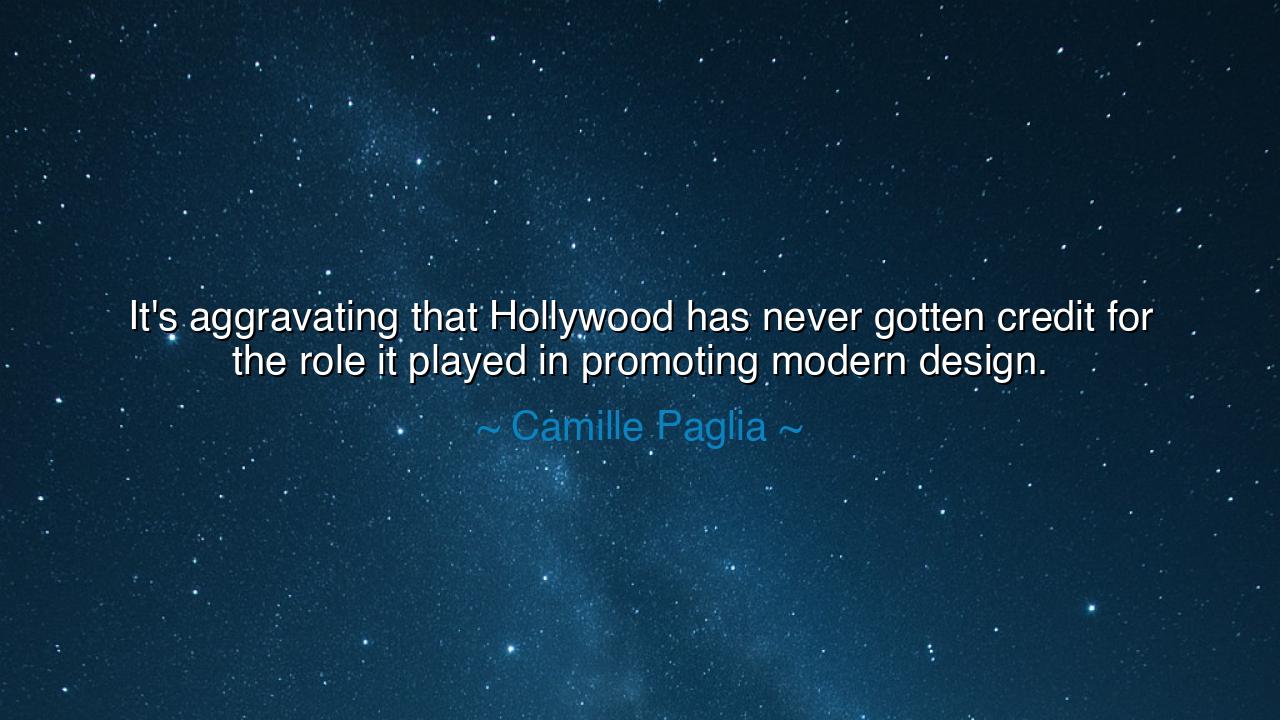
It's aggravating that Hollywood has never gotten credit for the
It's aggravating that Hollywood has never gotten credit for the role it played in promoting modern design.






"It's aggravating that Hollywood has never gotten credit for the role it played in promoting modern design." – Camille Paglia
In these pointed words, Camille Paglia, the cultural critic and scholar, draws attention to the unseen influence of one of the most powerful artistic institutions of the modern age. Hollywood, often dismissed as mere entertainment, has in fact served as a crucible for modern design, shaping aesthetics, architecture, fashion, and visual language in ways that reach far beyond the silver screen. Paglia’s observation reminds us that art and culture are not isolated; they ripple through society, often invisibly, and the work of one medium can elevate others, influencing public taste and the evolution of creative expression.
The origin of this quote lies in Paglia’s deep engagement with both art history and contemporary culture. In her writings and lectures, she frequently emphasizes how cinema, though commercial and populist, has been a platform for avant-garde ideas in visual design, set decoration, costume, and cinematography. Hollywood’s grand studios, in their search for spectacle and authenticity, have often commissioned groundbreaking work in interior design, fashion, and product aesthetics, offering modern designers a public showcase that shapes cultural perception. Yet, as Paglia notes, this contribution is rarely recognized outside scholarly or insider circles, leaving the industry uncredited for its transformative impact.
This insight finds echoes in the wisdom of the ancients, who observed that influence often travels unseen. Plato, in his discussions of mimesis, noted that art both reflects and shapes the society that consumes it. The Greek theaters, for instance, were not only stages for drama but laboratories for costume, architecture, and spectacle — all of which influenced broader cultural norms. Hollywood operates in a similar manner today: the visual and material culture portrayed on screen seeps into homes, offices, and public spaces, molding tastes in ways that are profound yet subtle, shaping the collective imagination.
Consider the story of Cedric Gibbons, the legendary art director at MGM during Hollywood’s Golden Age. Gibbons designed sets for thousands of films, many reflecting Art Deco aesthetics long before the style became widely embraced in architecture and interior design. Through cinema, Gibbons’s work reached millions, influencing both public and professional sensibilities. Paglia’s statement resonates here: Hollywood, through visionaries like Gibbons, acted as a cultural vector, introducing and promoting modern design in ways that textbooks alone never could.
Paglia’s remark also underscores the tension between perception and contribution. Hollywood is often criticized for commercialism, sensationalism, or superficiality, yet this critique obscures its role as a catalyst for artistic innovation. The sets, costumes, and cinematography that define classic films have informed not only design theory but practical applications in homes, theaters, and public spaces. By neglecting this contribution, society underestimates the power of popular culture to elevate taste and disseminate aesthetic ideas on a massive scale.
Moreover, the quote encourages reflection on the interconnectedness of creative fields. Design does not exist in isolation; it thrives when cross-pollinated with other disciplines. Hollywood’s work in film, whether through collaboration with designers, architects, or costume makers, exemplifies this synergy. Great design in one realm inspires innovation in another, demonstrating that creativity is a network, and that cultural influence often spreads in unexpected directions. Paglia’s frustration is, therefore, not only about recognition but about understanding the holistic web of artistic creation.
Lesson: My children, learn to recognize the subtle channels through which influence flows. Do not dismiss popular culture as trivial, for it may carry the seeds of profound innovation. Study the works of others, observe how ideas migrate across disciplines, and honor contributions even when they come from unexpected sources. Like Hollywood’s unseen impact on modern design, greatness often lies in the intersections, in the spaces where art, commerce, and culture converge to inspire, educate, and transform.
In the end, Paglia’s insight calls us to pay attention and give credit where it is due. The institutions that shape our tastes and our environments deserve recognition not only for their immediate outputs but for their enduring influence on human creativity. Hollywood, like the theaters of Athens or the ateliers of Renaissance Florence, reminds us that art is a living dialogue, spreading beauty, inspiring innovation, and shaping the world in ways both visible and invisible.






AAdministratorAdministrator
Welcome, honored guests. Please leave a comment, we will respond soon